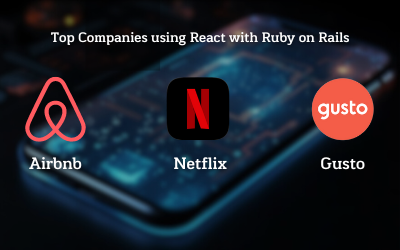The combination of React with Rails marks the dawn of a new era in web application development. Both of these make for a great duo when creating modern web applications. React is a JavaScript library that assists in building user interfaces, while Rails is a robust web development framework. When paired, these two together provide a powerful platform for creating exceptional web solutions.
Approximately 438,731 websites have chosen to employ Ruby on Rails for their framework. A mere 4.1% of all websites on the internet utilise React technology.
Through this article, we’ll dive into the significance of using React Ruby on Rails to create modern, engaging web applications.

6 Reasons to Choose React with Rails for web application development
When developing a web app, your chosen framework will significantly impact the user interface and experience. It’s important to note that there may be better approaches than relying solely on user statistics to make this decision. React with Rails is a popular combination for building modern web apps. Here are some key reasons why it’s a popular choice:
- Faster development
By integrating Ruby on Rails and React, page load times and front-end performance can be optimised. What’s more, managing any changes or additions is simpler since all necessary elements are in one location.
New components, such as an eCommerce store or search functionality, can be effortlessly incorporated by including a new API endpoint or script that operates on the server. Every alteration is synchronised seamlessly throughout the front and back end, making it more straightforward to manage and lessening the time spent developing.
- Performance
Performance is critical for ensuring a satisfying user experience on your website. Developers must prioritise it in order to meet users’ expectations. That is why a combination of React and Ruby on Rails web application servers is the ideal setup.
Modern web apps need to be able to run smoothly, or else people won’t use them. React is the perfect framework to help guarantee that. It provides modularity, allowing every part of your web app to maintain its own communication protocol. This ensures optimum performance, giving your website an edge over the competition and earning a loyal user base.
- Reduced Server Request Time
Maintaining a separation between client-side and server-side code is essential when employing a conventional MVC framework. By segregating client-side and server-side code, it is possible to avoid complex technical scenarios and mitigate potential problems. Additionally, if a technical issue arises, it can be solved in an isolated manner rather than affecting multiple components.
Furthermore, optimising Rails’ asset pipeline can minimise requests made to the server for JS/CSS files. This has a positive effect on page loading times and the scalability of the application.
- Modularity
The utilisation of Ruby with Rails offers developers an array of modular options that can be tailored to meet the needs of even the most seasoned professionals. With React on Rails, developers can benefit from two frameworks that combine to create an application that is robust and highly flexible. The integration of these two separate frameworks allows for endless combinations of techniques and strategies that can be applied to each project.
- Maintainability
By combining React with Ruby on Rails, development teams can save both time and money. With fewer lines of code to write and maintain, this powerful combination decreases the amount of code and minimises the potential for costly bugs in the application.
Furthermore, React developers can access an array of pre-made components, such as form fields, calendars, modals, and more, to quickly and effectively build visually-appealing user interfaces.
- Development Quality
Working with React and Rails to build modern web applications lets you quickly bring your product to market. Nevertheless, the more important factor here is development quality. Though the development cycle may be expedited, it does not mean that quality can be compromised.
React provides an advantageous development speed as it utilises reusable components instead of the classic templates usually employed by a Ruby on Rails application. Additionally, unnecessary duplication of code can be avoided as there is no requirement to link external libraries when parts of the application are not dependent on each other, which would be a likely outcome in an MVC framework.
Top Companies using React with Ruby on Rails
Many renowned organisations around the globe have leveraged the powerful duo of React and Rails to create cutting-edge web applications. Let’s have a look at a few of the best:
- Airbnb
React, and Rails are effectively combined in Airbnb’s approach, allowing the brand to benefit from Rails for SSR configuration, Ruby for their main coding language, and ReactJS for a consistent and efficient user experience.
- Netflix
Ruby on Rails has a critical role in powering the microservices and formidable security measures of Netflix, a renowned video streaming service with a sophisticated technical infrastructure.
- Gusto
Gusto, a cloud-based HR and payroll provider for small businesses, has leveraged React for a dynamic and interactive user experience and Ruby on Rails for the necessary backend technology to sustain its functionalities.
To Sum Up
If you’re looking to create a modern web application, consider using React and Rails together. These frameworks are trusted, effective and have been utilised by some of the world’s most successful businesses. By combining them, you can expect quick and efficient performance with a seamless user experience. If you want functional web application development, we recommend React with Rails. Our team of experts is available to offer further guidance and support.







